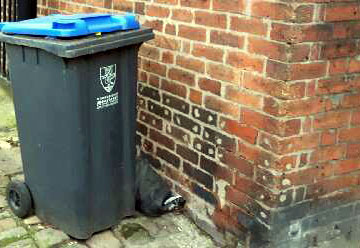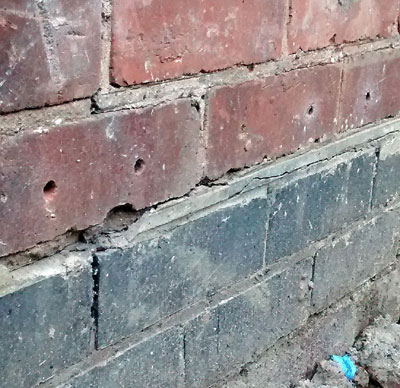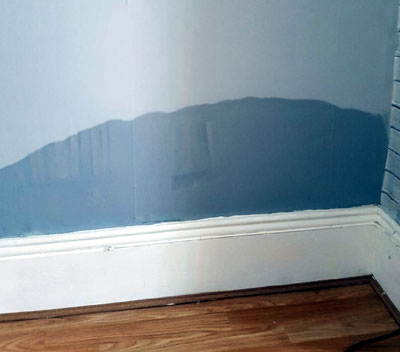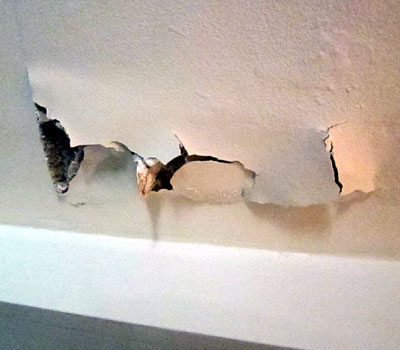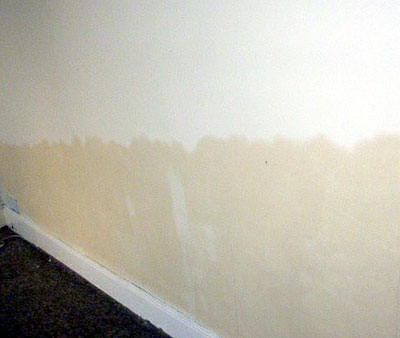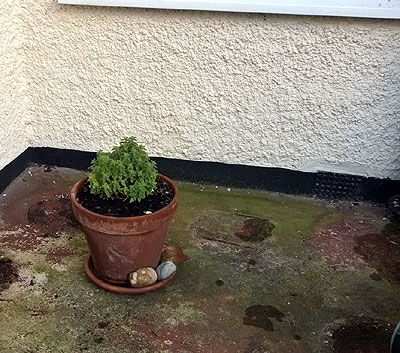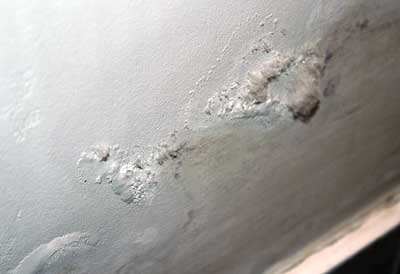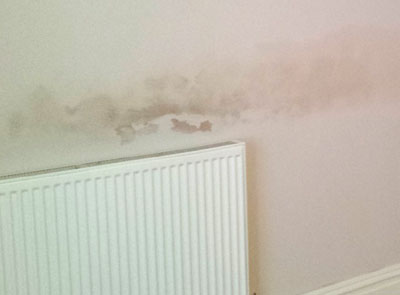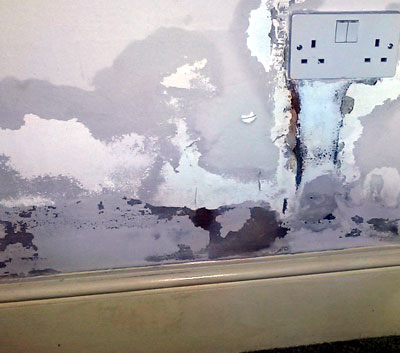Do any of these photos look similar to your building?
Contact us if you need help with damp - 01626 872886 .
We are long term members of the PCA - The Property Care Association - the professional body for the Damp Proofing industry and our Dampness Surveyors have over 50 years of experience between them.
Want Help choosing a Contractor - E: Mail us at help@propertyrepairsystems.co.uk
Chemical Injection above a perfectly good slate damp proof course - not necessary
Chemical Damp Proof Courses are usually injected into holes varying in diameter from 10mm to 22mm.
Sometimes these holes have been injected several times over the years,l or new rows of holes have been drilled. Note the thicker mortar line where the original damp proof course is sitting - the loss of surface mortar is not significant and does not mean that the DPC is damaged - this can simply be repointed.
Also note the blue/black Engineering Bricks below the original DPC - these are very hard and tough and do not readily absorb water. There should be no need in this case to insert a new damp proof course.
Check the source of your damp for yourself - it is not difficult - click here
See our Article about installing different types of Damp Proof Course - click here.
See our Shop for damp proofing pumps and equipment - click here
For help with installation methods and rules call our experts on 01626 872886 .
The answer is usually:
That the dampness was caused by raised external ground levels or a water leak from a drain, a water main, a foul water pipe or a central heating pipe. We will help you or your Builder/Plumber to find the cause.
The solution is:
Lower the ground level, or find and fix the leak(s), remove the indoor plaster (if damaged) and fit our Mesh Membrane - then replaster. A Guaranteed result - guaranteed for 20 years.
Mesh Membrane - click here
Wall stain that is wet - not natural rising damp: it is entirely man-made
Below - Man Made Rising Damp - water leak
Before spending money on one go to our Diagnosis page and check the source of your damp for yourself - we don't mind explaining - click here
For help with the causes of damp call our experts on 01626 872886 .
The answer is usually:
That the dampness was not Natural at all, but was caused by raised external ground levels or a water leak from a drain, a water main, a foul water pipe or a central heating pipe. We will help you or your Builder/Plumber to find the cause.
The solution is:
Lower the ground level, or find and fix the leak(s), remove the indoor plaster (if damaged) and fit our Mesh Membrane - then replaster. A Guaranteed result - guaranteed for 20 years.
Mesh Membrane - click here
Tide line with staining - not natural rising damp, does not require injection
Typical example - yes the damp is rising, but it is not natural ground dampness
A water leak will be found next door - in this case, a leaking Main.
The answer is usually:
That the dampness was not Natural at all, but was caused by a water leak from a drain, a water main, a foul water pipe or a central heating pipe. Do not rule out leaks being from a neighboring property or road. Always look inside neighboring properties to be safe. We will help you or your Builder/Plumber to find the cause.
The solution is:
Find and fix the leak(s), remove the indoor plaster (if damaged) and fit our Mesh Membrane - then replaster. A Guaranteed result - guaranteed for 20 years.
Mesh Membrane - click here
White salts pushing off the plaster, paper or paint - not natural rising damp, does not require chemical injection
Below - severe salts damage, plaster will not recover.
This damage requires the plaster to be hacked off completely.
(Note - the degree of repellence shown is hugely optimistic because damp continues to rise up to the new DPC.)
Don't spend money yet - go to our Diagnosis page and check your damp for yourself - you have nothing to lose - click here
For help with how damp proof courses work call our experts on 01626 872886 .
The answer is usually:
That the salts will never dry out, even when the moisture source is removed. Some of them absorb moisture from the air - they are said to be 'hygroscopic'.
Replastering or rendering, or Tanking with liquids over salts will always fail.
The solution is:
Lower the ground level, or find and fix the leak(s), remove the indoor plaster to bare brick/stone, apply Salt Neutraliser and then fit our Mesh Membrane - then replaster. A Guaranteed result - guaranteed for 20 years.
Mesh Membrane - click here
Damp wall in a modern house fitted with plastic DPC and DPM - does not require injection
Below - modern house, internal water leak.
This problem in a modern house NEVER requires to use of Tanking liquids, or the installation of a new Damp Proof Course.
Before spending money check your damp for yourself - we'll help you for free - click here
For help with types of damp proofing fluids and creams and where to use them call our experts on 01626 872886 .
Raised ground levels don't matter - yes they do
Below - concrete yard level too high relative to the damp proof course and Air Brick.
This will cause rain water splash up to penetrate the wall causing damp inside.
The answer is:
Building Regulations stipulate that ground levels should be at least 6 inches - 150mm - below the level of the damp proof course to prevent the lateral penetration of (rainwater splash up) dampness through the walls into the plaster and skirting boards.
The solution is:
Ideally lower the ground level, or, if that is not feasible, remove the indoor plaster and fit our Mesh Membrane - then replaster. A Guaranteed result - guaranteed for 20 years.
Mesh Membrane - click here
Internal walls are damp - these do not require chemical injection
In reality, walls that have no external outside face (said to be' internal' walls) are never likely to need damp proof injection - because they are never likely to suffer from natural rising damp.
Internal walls are most likely to suffer from water leaks under the floor - mains water, sewage (but note - there is unlikely to be a smell due to the filtering effect of the soil), or central heating leaks. Check all these systems first - see our Water Leak Testing section - click here.
If the internal wall is a shared wall (Party Wall) go next door and ask to see the matching area - the source may not be under your house.
Your House Insurance may cover the cost of repair - check your Insurance Excess and call the Insurer to advise them of the probable leak. Take lots of dated photographs as evidence.
Don't waste money on internal walls - go to our Diagnosis page and check your damp for yourself - save your money - click here
For help with types of damp proofing fluids and creams and where to use them call our experts on 01626 872886 .
The answer is usually:
That the dampness was caused by a water leak from a drain, a water main, a foul water pipe or a central heating pipe. We will help you or your Builder/Plumber to find the cause.
The solution is:
Find and fix the leak(s), remove the indoor plaster (if damaged) and fit our Mesh Membrane - then replaster. A Guaranteed result - guaranteed for 20 years.
Mesh Membrane - click here
Cavity walls suffer from natural rising damp - no, but they can be partially blocked
Walls that have a cavity (usually in older houses about 1 inch - 25mm wide, but up to 4 inches - 100mm in modern houses) between the inner and outer bricks or blocks, however small that cavity is, are never likely to need damp proof injection - because they are never likely to suffer from natural rising damp. A clean cavity gives good air flow between the walls and even if outside ground levels are a little high ('bridging' due to rainwater splash up) the evaporation inside the cavity will ensure that dampness does not travel through the inner leaf to spoil decorations.
Cavity walls are most likely to suffer from debris in the cavity or damp cavity insulation - see our Article about cavity walls - click here.
Your cavity may have been filled with foam, polystyrene beads or Rockwool. Ask the Installer to check for debris in the cavity - such debris allows moisture to move from outside to inside, both above and below the damp proof course. Rockwool may become soggy if enough dampness is trapped.
Ask for details of our Cavity Cleaning Method.
For help with types of damp proofing fluids and creams and where to use them call our experts on 01626 872886 .
The answer is usually:
That the dampness was caused by debris (mortar, sand, brick pieces, dirty wall ties, badly installed cavity insulation) and then the moisture from raised external ground levels or a water leak from a drain, a water main, a foul water pipe can cross the cavity from the outside Otherwise the problem may be an internal leak. . We will help you or your Builder/Plumber to find the cause.
The solution is:
Clean out the cavity, lower the ground level, or find and fix the leak(s), remove the indoor plaster (if damaged) and fit our Mesh Membrane - then replaster. A Guaranteed result - guaranteed for 20 years.
Mesh Membrane - click here
Salt band appearing above replastered areas - sand and cement backing coat has concealed the fault
Salts bursting through paint - Render or Tanking can drive this higher
Don't drive water up your wall behind a waterproof layer - go to our Diagnosis page and check your damp for yourself - save some money and time - click here
For help with types of damp proofing fluids and creams and where to use them call our experts on 01626 872886 .
Floating band of damp and salt emerging above renewed plaster on 'waterproofed' render.
Note the perfect plaster below the band - the problem has been concealed by the render backing coat.
The answer is usually:
That the dampness was caused by raised external ground levels or a water leak from a drain, a water main, a foul water pipe or a central heating pipe. Using Tanking to seal the wall simply causes the moisture to rise further. Even sand and cement render may mask the problem, but eventually dampness will appear above the renewed area. We will help you or your Builder/Plumber to find the cause.
The solution is:
Lower the ground level, or find and fix the leak(s), remove the indoor plaster (if damaged) and fit our Mesh Membrane - then replaster. A Guaranteed result - guaranteed for 20 years.
Mesh Membrane - click here
Old buildings are likely to need a chemical damp proof course - no, they are not
Below - repaired plaster over previous dampness,
This needs investigation - buildings do not suffer sudden patches of damp proof course failure.
The answer is usually:
That the dampness was caused by raised external ground levels or a water leak from a drain, a water main, a foul water pipe or a central heating pipe. We will help you or your Builder/Plumber to find the cause.
The solution is:
Lower the ground level, or find and fix the leak(s), remove the indoor plaster (if damaged) and fit our Mesh Membrane - then replaster. A Guaranteed result - guaranteed for 20 years.
Mesh Membrane - click herre
Rising damp can be confirmed using a Damp Meter - not it cannot, do not be fooled
Natural Rising damp is very, very difficult to confirm. It requires the use of Laboratory Testing and wall samples taken from multiple locations for each wall.
So when a local 'expert' or 'specialist' using a so-called Damp Meter advises you that you have Rising Damp and offers to inject and replaster the walls, ask them if they have any qualifications and if they have read this book.
Quick DIY Master Class in Dampness and Condensation - Click here to buy the reprint.
This book was written by Graham Coleman, who is a Lecturer in dampness and who has set many of the examinations.
He confirms in his book that a Damp Meter is not be be used to confirm that rising damp is present and he also explains how proper tests can be performed.
In practice these tests are rarely needed - simpler, less expensive options exist - but in 'legal' Cases Graham is often involved as an Expert Witness.
Click here to see our Dampness Guide for using a Damp Meter. - page 1
Click here to see our Dampness Guide for using a Damp Meter. - page 2
Property Care Association
We are long term members of the PCA - The Property Care Association - the professional body for the Damp Proofing industry and our Dampness Surveyors have over 50 years of experience between them.
If you prefer to use a Contractor, rather than our free advice service, then go to the PCA Website where you can find the nearest qualified specialist companies. They should give you the same information that we provide. If in doubt E Mail their Reports to us for checking, before spending any money.
Link for the PCA - click here.
Want Help choosing a Contractor - E: Mail us at help@propertyrepairsystems.co.uk
Index Page | Privacy Policy | Returns Policy | Contact | Links | Technical References
OUR SHOPPING PAGES
- DAMP SHOP - this Site, for Damp problem solving in buildings
- TANKING SHOP - this Site, for Damp problems below ground level
- MOLD SHOP - this Site, for Mold problems and their solutions
- SURVEYING TOOLS SHOP - this Site, for tools for surveying your building for damp
- DAMP PROOFING EQUIPMENT SHOP - pumps, injection rods, spray lances
Property Repair Systems
T: 01626 872886
E: Mail us help@propertyrepairsystems.co.uk
Site written by: David Moore
David Moore, B.A. (Hons.), C.T.I.S., C.R.D.S. Technical Author
Google+
Other Property Repair Systems Sites:
www.boron.org.uk - how to use Boron based insecticides/fungicides to treat timber rots and insect attack
www.deck-treatment.co.uk - how to treat patio decks and yacht decks
www.dryrot.biz - how to kill Dry Rot in buildings
www.drywallandfloor.co.uk - membranes for lining damp walls, floors, basements and cellars
www.epoxy-info.co.uk - resins for repairing and sealing all types of masonry
www.fire-door-paint.co.uk - upgrade doors to 30 minutes fire resistance
www.joist-repair.co.uk - how to quickly repair joists and beams of any size
www.propertyrepairsystems.co.uk - our Home Site
www.steel-fire-paint.co.uk - treat steel with Intumescent Paint to provide fire protection
www.timber.org.uk - systems of repair, with step by step methods
www.timber-repair.co.uk - how to repair timber beams
www.woodworm-info.co.uk - how to kill and prevent woodworm and death watch beetle
www.woodworm-expert-advice-forum.org.uk - all your questions and our answers about woodworm treatment DIY
